286 scholarly books by Haus Publishing and 30
have author last names that start with S
286 scholarly books by Haus Publishing and 30
286 scholarly books by Haus Publishing
30 have author last names that start with S have author last names that start with S
30 have author last names that start with S have author last names that start with S

The Geckos of Bellapais
Memories of Cyprus
Joachim Sartorius
Haus Publishing, 2013
The history of Cyprus offers a reflection of larger world history. Coveted by a succession of foreign powers, it has been repeatedly occupied: the Phoenicians, Greeks, Romans, Byzantines, crusaders, Venetians, Genoese, Ottomans, and British have all left their mark on this Mediterranean island. Alongside the Roman and early Byzantine ruins of Salamis, other impressive monuments date from the Frankish and Venetian times, including the Abbey of Bellapais; the fortified harbor of Kyrenia; the magnificent cathedrals of Nicosia; and Famagusta, the setting for Shakespeare’s Othello.
In The Geckos of Bellapais, Joachim Sartorius shares the cultures and legends, colors and lights of the Levant. He explores the island’s history—including its division after the Turkish invasion of 1974 and the difficulties that followed. A revealing exploration of Cyprus after the Turkish partition and an evocative account of one poet’s life on one of the most beautiful islands in the Mediterranean, this book belongs among the world’s best travel writing.
In The Geckos of Bellapais, Joachim Sartorius shares the cultures and legends, colors and lights of the Levant. He explores the island’s history—including its division after the Turkish invasion of 1974 and the difficulties that followed. A revealing exploration of Cyprus after the Turkish partition and an evocative account of one poet’s life on one of the most beautiful islands in the Mediterranean, this book belongs among the world’s best travel writing.
[more]
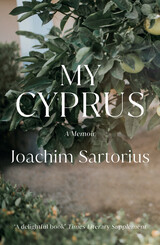
My Cyprus
A Memoir
Joachim Sartorius
Haus Publishing, 2021
A sensory and poetic guide to the island of Cyprus.
The island of Cyprus has been a site of global history and conquest, and its strategic position means it has been coveted by one foreign power after another. The Phoenicians, Greeks, Romans, Byzantines, Venetians, Genoese, Ottomans, and British have all left their mark. Along with the Roman and Byzantine ruins of Salamis, the island holds impressive monuments dating from the Frankish and Venetian times: the Abbey of Bellapais, the fortified harbor of Kyrenia, and the magnificent cathedrals of Nicosia and Famagusta, the setting for Shakespeare’s Othello.
Having lived in Cyprus for three years, Joachim Sartorius returns to the island’s cultures and legends and brings to life the colors and lights of the Levant area of the Middle East. He sifts through the sediments of the island’s history, including its division after the Turkish invasion of 1974 and the difficulties that followed. Rather than focusing solely on historical or political factors, this book is the work of a poet, who, with the help of both Greek and Turkish Cypriot friends, tries to understand this unique place.
The island of Cyprus has been a site of global history and conquest, and its strategic position means it has been coveted by one foreign power after another. The Phoenicians, Greeks, Romans, Byzantines, Venetians, Genoese, Ottomans, and British have all left their mark. Along with the Roman and Byzantine ruins of Salamis, the island holds impressive monuments dating from the Frankish and Venetian times: the Abbey of Bellapais, the fortified harbor of Kyrenia, and the magnificent cathedrals of Nicosia and Famagusta, the setting for Shakespeare’s Othello.
Having lived in Cyprus for three years, Joachim Sartorius returns to the island’s cultures and legends and brings to life the colors and lights of the Levant area of the Middle East. He sifts through the sediments of the island’s history, including its division after the Turkish invasion of 1974 and the difficulties that followed. Rather than focusing solely on historical or political factors, this book is the work of a poet, who, with the help of both Greek and Turkish Cypriot friends, tries to understand this unique place.
[more]

The Princes' Islands
Istanbul's Archipelago
Joachim Sartorius
Haus Publishing, 2011
Off the coast of Istanbul, in the Marmara Sea, lie the Princes Islands, an archipelago of unusual natural beauty, which has long been considered the maritime suburb of the imperial capital on the Bosporus and effectively shaped by its manifold history. The poet Joachim Sartorius draws a loving portrait of the landscape and the light, the political observer Sartorius describes the microcosm, which was always a reflection of Istanbul-Constantinople-Byzantium, while the novelist Sartorius introduces us to the characters, who inhabit this time capsule.
[more]

Calligraphers Secret
Rafik Schami
Haus Publishing, 2011
Even as a young man, Hamid Farsi is acclaimed as a master of the art of calligraphy. But as time goes by, he sees that weaknesses in the Arabic language and its script limit its uses in the modern world. In a secret society, he works out schemes for radical reform, never guessing what risks he is running. His beautiful wife, Noura, is ignorant of the great plans on her husband’s mind. She knows only his cold, avaricious side and so it is no wonder she feels flattered by the attentions of his amusing, lively young apprentice. And so begins a passionate love story of a Muslim woman and a Christian man.
[more]

Dark Side of Love
Rafik Schami
Haus Publishing, 2011
A dead man hangs from the portal of St Paul Chapel in Damascus. He was a Muslim officer and he was murdered. But when Detective Barudi sets out to interrogate the man’s mysterious widow, the Secret Service takes the case away from him. Barudi continues to investigate clandestinely and discovers the murderer’s motive: it is a blood feud between the Mushtak and Shahin clans, reaching back to the beginnings of the 20th century. And, linked to it, a love story that can have no happy ending, for reconciliation has no place within the old tribal structures. Rafik Schami dazzling novel spans a century of Syrian history in which politics and religions continue to torment an entire people. Simultaneously, his poetic stories from three generations tell of the courage of lovers who risk death sooner than deny their passions. He has also written a heartfelt tribute to his hometown Damascus and a great and moving hymn to the power of love.
[more]

The Language of Birds
Norbert Scheuer
Haus Publishing, 2018
It is 2003, and Paul Arimond is serving as a paramedic in Afghanistan. The twenty-four-year-old has no illusions of becoming a hero. Rather, he has chosen the army to escape the tragedies of his past and his own feelings of guilt. As a result, he finds himself in the same land, now war-torn, where an ancestor of his, Ambrosius Arimond, a late eighteenth-century traveler and ornithologist, once explored and developed the theory of a universal language of birds.
As visceral horrors and everyday banalities of the war threaten to engulf Paul, he, like his great-great-grandfather, finds his very own refuge in Afghanistan’s natural world. In a diary filled with exquisite drawings of birds and ruminations on the life he left behind, Paul describes his experiences living with two comrades who are fighting their own demons and his befriending of an Afghan man, Nassim, as well as his dreams of escaping the restrictive base camp and visiting the shores of a lake visible from the lookout tower. But when he finally reaches the lake one night, he finds himself in the midst of a chain of events that, with his increasingly fragile state of mind, has dramatic—and ultimately heartbreaking—consequences.
A meditative novel that shows a new side to the conflict in Afghanistan, The Language of Birds takes a moving look at the all-too-human costs of war and questions what it truly means to fight for freedom.
As visceral horrors and everyday banalities of the war threaten to engulf Paul, he, like his great-great-grandfather, finds his very own refuge in Afghanistan’s natural world. In a diary filled with exquisite drawings of birds and ruminations on the life he left behind, Paul describes his experiences living with two comrades who are fighting their own demons and his befriending of an Afghan man, Nassim, as well as his dreams of escaping the restrictive base camp and visiting the shores of a lake visible from the lookout tower. But when he finally reaches the lake one night, he finds himself in the midst of a chain of events that, with his increasingly fragile state of mind, has dramatic—and ultimately heartbreaking—consequences.
A meditative novel that shows a new side to the conflict in Afghanistan, The Language of Birds takes a moving look at the all-too-human costs of war and questions what it truly means to fight for freedom.
[more]

The Earth
Natural Resources and Human Intervention
Friedrich Schmidt-Bleek
Haus Publishing, 2009
Population growth mainly occurs in fast-developing, and developing nations. Can earth sustain this growth? How will the power shift? This book offers prospects on causes and effects of population growth and the age-ing population in industrialised countries.
[more]

Cornflower Blue
A Case for Milena Lukin
Christian Schünemann
Haus Publishing, 2015
Based on true events, Cornflower Blue is a tense thriller that explores the troubled legacy of the Bosnian War.
On the night of the eleventh of July, two elite Serbian soldiers are on sentry duty at the Topcider military camp. The next morning, they are found dead. A military court declares them victims of a ritual suicide, and the investigation is closed. But inconsistencies in the official tribunal draw criminologist Milena Lukin to the case. What did the two guardsmen see on that fateful night, a date marking the anniversary of the Srebrenica genocide? Up against a military complex with a history to hide, Milena soon finds herself in grave danger. Meticulously researched and rich in historical detail, Cornflower Blue is a gripping tale that bravely addresses one of the darkest hours in Europe’s recent history.
“An exciting thriller, a story about the worst depths of human nature—but also a clever, nostalgic, loving homage to Belgrade and its inhabitants.”—Der Tagesspiegel, on the German edition
On the night of the eleventh of July, two elite Serbian soldiers are on sentry duty at the Topcider military camp. The next morning, they are found dead. A military court declares them victims of a ritual suicide, and the investigation is closed. But inconsistencies in the official tribunal draw criminologist Milena Lukin to the case. What did the two guardsmen see on that fateful night, a date marking the anniversary of the Srebrenica genocide? Up against a military complex with a history to hide, Milena soon finds herself in grave danger. Meticulously researched and rich in historical detail, Cornflower Blue is a gripping tale that bravely addresses one of the darkest hours in Europe’s recent history.
“An exciting thriller, a story about the worst depths of human nature—but also a clever, nostalgic, loving homage to Belgrade and its inhabitants.”—Der Tagesspiegel, on the German edition
[more]
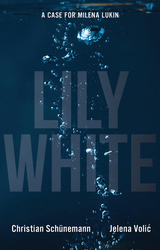
Lily White
Christian Schünemann
Haus Publishing, 2021
A thrilling crime novel set in Belgrade that dives into Serbia’s troubled history.
Jelena Volić and Christian Schünemann’s latest thriller follows a case for criminologist Milena Lukin, the protagonist of their previous novels Cornflower Blue and Peony Red. Set in Belgrade, a city of flux between East and West, Lily White is a complex and riveting new story that once again will take Lukin to the dark heart of Serbia’s past.
Bouquets of white lilies are mysteriously laid in a Belgrade street where, years earlier, a small Romani boy was beaten to death by two youths. One of the attackers was apprehended and imprisoned. The other was allowed to flee and, after twenty-five years on the run, he returns to Belgrade to confront his past. Days later, his corpse is found floating in the Danube River. After a cursory investigation, the police declare it to have been suicide and close the case, but the dead man’s lawyer and the criminologist Milena Lukin begin an investigation of their own. They soon stumble upon a clue that leads them into the darkest recesses of Serbian politics and to the root of a murder that shaped the fate of a country.
Jelena Volić and Christian Schünemann’s latest thriller follows a case for criminologist Milena Lukin, the protagonist of their previous novels Cornflower Blue and Peony Red. Set in Belgrade, a city of flux between East and West, Lily White is a complex and riveting new story that once again will take Lukin to the dark heart of Serbia’s past.
Bouquets of white lilies are mysteriously laid in a Belgrade street where, years earlier, a small Romani boy was beaten to death by two youths. One of the attackers was apprehended and imprisoned. The other was allowed to flee and, after twenty-five years on the run, he returns to Belgrade to confront his past. Days later, his corpse is found floating in the Danube River. After a cursory investigation, the police declare it to have been suicide and close the case, but the dead man’s lawyer and the criminologist Milena Lukin begin an investigation of their own. They soon stumble upon a clue that leads them into the darkest recesses of Serbian politics and to the root of a murder that shaped the fate of a country.
[more]

Peony Red
A Case for Milena Lukin
Christian Schünemann
Haus Publishing, 2018
In the Balkans, there is a saying: only where the ground was once soaked with blood will the peony bloom with its full, dizzying red.
When a young couple is murdered in their home in Kosovo, police are perplexed: there seems to be no motive. But when Milena Lukin’s uncle realizes that the murdered woman was his first love, his niece decides to investigate. All too soon, she is embroiled in the twisted world of Balkan politics, where the past always weighs heavy on the present, and nowhere more so than in her hometown of Belgrade. Old prejudices and new hatreds, merciless profiteers and mendacious politicians—all come together to try to keep Lukin from finding the truth.
A fast-paced, deftly told thriller Peony Red drops readers into the murky Balkan underworld. Fortunately, in Milena Lukin, they have a strong, capable, no-nonsense guide, one whose adventures will always keep the pages turning.
When a young couple is murdered in their home in Kosovo, police are perplexed: there seems to be no motive. But when Milena Lukin’s uncle realizes that the murdered woman was his first love, his niece decides to investigate. All too soon, she is embroiled in the twisted world of Balkan politics, where the past always weighs heavy on the present, and nowhere more so than in her hometown of Belgrade. Old prejudices and new hatreds, merciless profiteers and mendacious politicians—all come together to try to keep Lukin from finding the truth.
A fast-paced, deftly told thriller Peony Red drops readers into the murky Balkan underworld. Fortunately, in Milena Lukin, they have a strong, capable, no-nonsense guide, one whose adventures will always keep the pages turning.
[more]

An Armchair Traveller's History of Apulia
Desmond Seward
Haus Publishing, 2013
An Armchair Traveller's History of Apulia is the story of the heel of Italy - Puglia - as told by past and present day travellers. It has beautiful landscapes, cave towns and frescoed grotto churches, wonderful old cities with Romanesque cathedrals, Gothic castles and a wealth of Baroque architecture. And yet, while far from inaccessible, until quite recently it was seldom visited by tourists. This portrait of Apulia concentrates on the Apulian people down the ages. Conquerors, whether Messapians, Greeks, Romans, Arabs, Lombards, Byzantines, Normans, Angevins, Germans or Spaniards, have all left their mark on the region in a cultural palimpsest that at first sight bewilders, but which hugely repays investigation. Arranged in short chapters, the narrative travels from north to south, making it an ideal companion for exploring Apulia by car. The Gazetteer, which is cross-referenced to the main text, highlights cities, churches, cathedrals, castles and sites of historical importance to the visitor. For travellers on the ground or students at their desks, this elegant, cloth-bound book will prove invaluable.
[more]

Old Puglia
A Cultural Companion to South-Eastern Italy
Desmond Seward
Haus Publishing, 2016
Apulia (or Puglia) is the heel of Italy, stretching down from the spur of the Italian boot. Its landscape is often very beautiful and it has wonderful old cities with Romanesque cathedrals, Gothic castles and a great wealth of Baroque architecture, together with 'rupestrian' churches that contain Byzantine frescoes. But, although far from inaccessible, until quite recently it was seldom visited by Anglo Saxons. Today, however, Apulia is becoming fashionable, 'an alternative to Tuscany'. It is featured on radio and television; travel supplements describe its beaches and its cooking, supermarkets stock Apulian wine, oil, bread and pasta. Yet almost nothing about the region has been published in English since the days of Norman Douglas and the Sitwells. One can find 'holiday histories' of Tuscany, but there is no popular introduction to Apulian history, not even in Italian. Our book, which grew out of what was originally intended as a travel book, has been written to fill the gap by providing a simple, readable account.
[more]
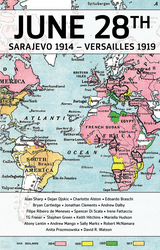
28 June
Sarajevo 1914 - Versailles 1919: The War and Peace That Made the Modern World
Alan Sharp
Haus Publishing, 2014
On June 28, 1919, the Peace Treaty was signed in the Hall of Mirrors at Versailles, five years to the day after the assassination of Archduke Franz Ferdinand in Sarajevo triggered Europe's precipitous descent into war. This war was the first conflict to be fought on a global scale. By its end in 1918, four empires had collapsed, and their minority populations, which had never before existed as independent entities, were encouraged to seek self-determination and nationhood.
Following on from Haus’s monumental thirty-two Volume series on the signatories of the Versailles peace treaty, The Makers of the Modern World, 28 June looks in greater depth at the smaller nations that are often ignored in general histories, and in doing so seeks to understand the conflict from a global perspective, asking not only how each of the signatories came to join the conflict but also giving an overview of the long-term consequences of their having done so.
Following on from Haus’s monumental thirty-two Volume series on the signatories of the Versailles peace treaty, The Makers of the Modern World, 28 June looks in greater depth at the smaller nations that are often ignored in general histories, and in doing so seeks to understand the conflict from a global perspective, asking not only how each of the signatories came to join the conflict but also giving an overview of the long-term consequences of their having done so.
[more]

Consequences of Peace
The Versailles Settlement - Aftermath and Legacy
Alan Sharp
Haus Publishing, 2010
Consequences of Peace: The Versailles Settlement - Aftermath and Legacy. This final volume in the Paris Peace Conference series will evaluate the immediate and later effects of the last great peace gathering which sought to settle the world's affairs at a stroke - something that was not attempted after either the Second World War or the Cold War. The Versailles settlement has not enjoyed a great reputation. It has been blamed for causing a second major conflict within a generation, thus apparently fulfilling Marshal Foch's gloomy prediction that "This is not a peace, it is an armistice for twenty years." More recently commentators have suggested that the post-1989 ethnic disturbances in the Balkans and on the fringes of the former Soviet Union are "the old chickens of Versailles coming home to roost." The contemporary world still struggles to come to terms with the implications of President Woodrow Wilson's troublesome principle of national self-determination, and remains embroiled in the ambiguities and complexities of the Middle East, an area for whose boundaries and problems the Great War and settlement bear significant responsibility. We are also still seeking to realise more effectively some of the nobler ambitions of the peacemakers, expressed in the Covenant of the League of Nations, in their concern for the human rights of minority nationalities left on the wrong side of the new borders that they sanctioned, and in their attempt to extend criminal responsibility for war beyond the operational irregularities of combatants to political and military leaders. Ninety years on, the settlement still casts a long shadow.
[more]
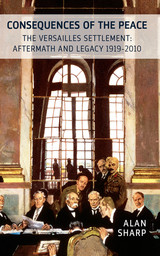
The Consequences of the Peace
The Versailles Settlement: Aftermath and Legacy 1919-2015
Alan Sharp
Haus Publishing, 2015
The Versailles Settlement, at the time of its creation a vital part of the Paris Peace Conference, suffers today from a poor reputation: despite its lofty aim to settle the world’s affairs at a stroke, it is widely considered to have paved the way for a second major global conflict within a generation. Woodrow Wilson’s controversial principle of self-determination amplified political complexities in the Balkans, and the war and its settlement bear significant responsibility for boundaries and related conflicts in today’s Middle East. After almost a century, the settlement still casts a long shadow.
This revised and updated edition of The Consequences of the Peace sets the ramifications of the Paris Peace treaties—for good or ill—within a long-term context. Alan Sharp presents new materials in order to argue that the responsibility for Europe’s continuing interwar instability cannot be wholly attributed to the peacemakers of 1919–23. Marking the centenary of World War I and the approaching centenary of the Peace Conference itself, this book is a clear and concise guide to the global legacy of the Versailles Settlement.
This revised and updated edition of The Consequences of the Peace sets the ramifications of the Paris Peace treaties—for good or ill—within a long-term context. Alan Sharp presents new materials in order to argue that the responsibility for Europe’s continuing interwar instability cannot be wholly attributed to the peacemakers of 1919–23. Marking the centenary of World War I and the approaching centenary of the Peace Conference itself, this book is a clear and concise guide to the global legacy of the Versailles Settlement.
[more]

David Lloyd George
Great Britain
Alan Sharp
Haus Publishing, 2010
David Lloyd George (1863-1945). The end of the First World War saw Britain at the height of its power. Its fleet and air force were the largest in the world. Its armies had triumphed in the Middle East and spearheaded the final attacks in Western Europe that had driven the defeated Germans to seek an armistice. Britain now had to translate this military victory into the achievement of its war aims and future security and prosperity. Its main negotiator at the forthcoming peace conference would be its prime minister, the ebullient and enigmatic David Lloyd George, the "Welsh Wizard" and "the man who had won the war." Lloyd George's energy had maintained the war effort through the dark days of 1917 and early 1918, but now he anticipated, with relish, the prospect of winning the peace. Few were better equipped. He was a skilled and accomplished negotiator with the knack of reconciling the apparently irreconcilable. His admirers, of whom there were many, pointed to his brilliant and agile mind, his rapid grasp of complex questions and his powers of persuasion. His critics, who were also numerous, distrusted his sleight of hand, fleetness of foot and, frankly, his word. His six months in Paris in 1919, as he pitted his wits against formidable world leaders like Woodrow Wilson and Georges Clemenceau, were among the most enjoyable but exhausting of his life. This study investigates the extent to which Lloyd George succeeded in his aims and evaluates the immediate and longer-term results of his negotiations for Britain.
[more]

Versailles 1919
A Centennial Perspective
Alan Sharp
Haus Publishing, 2018
The Versailles Settlement, at the time of its creation a vital part of the Paris Peace Conference, suffers today from a poor reputation: despite its lofty aim to settle the world’s affairs at a stroke, it is widely considered to have paved the way for a second major global conflict within a generation. Woodrow Wilson’s controversial principle of self-determination amplified political complexities in the Balkans, and the war and its settlement bear significant responsibility for boundaries and related conflicts in today’s Middle East. After almost a century, the settlement still casts a long shadow.
Fully revised and updated for the centennial of the Conference, Versailles 1919 sets the ramifications of the Paris Peace treaties—for good or ill—within a long-term context. Alan Sharp mounts a powerful argument that the responsibility for Europe’s continuing interwar instability cannot be wholly attributed to the peacemakers of 1919–23. Concise and convincing, Versailles 1919 is a clear guide to the global legacy of the Versailles Settlement.
Fully revised and updated for the centennial of the Conference, Versailles 1919 sets the ramifications of the Paris Peace treaties—for good or ill—within a long-term context. Alan Sharp mounts a powerful argument that the responsibility for Europe’s continuing interwar instability cannot be wholly attributed to the peacemakers of 1919–23. Concise and convincing, Versailles 1919 is a clear guide to the global legacy of the Versailles Settlement.
[more]

Britain in a Perilous World
The Strategic Defence and Security Review We Need
Jonathan Shaw
Haus Publishing, 2014
The British government periodically publishes a Strategic Defence and Security Review, an appraisal of the armed forces that seeks to understand and prepare for the defense challenges that lie ahead. This report is often controversial—the 2010 review, for example, made headlines for all the wrong reasons, as major defense projects such as the NIMROD aircraft were discontinued at huge cost, while other projects were maintained only because they were too expensive to abandon.
In advance of the 2015 Strategic Defence and Security Review, Jonathan Shaw argues persuasively for the need to rethink how governments and Whitehall devise their strategies and reach crucial decisions. Beginning with the review’s often imprecise use of language, Shaw challenges the assumptions that underlie the British government’s current practices. Ultimately, he suggests how Whitehall can improve its approaches and, equally important, its credibility.
In advance of the 2015 Strategic Defence and Security Review, Jonathan Shaw argues persuasively for the need to rethink how governments and Whitehall devise their strategies and reach crucial decisions. Beginning with the review’s often imprecise use of language, Shaw challenges the assumptions that underlie the British government’s current practices. Ultimately, he suggests how Whitehall can improve its approaches and, equally important, its credibility.
[more]

Lenin
Seán Sheehan
Haus Publishing, 2003
Views of Lenin are currently set in a tone of highly judgemental opinion: he was inflexible, doctrinaire and a cold-blooded revolutionary. A man whose indifference to culture led to political extremes, paving the way for his successor Stalin’s totalitarianism and some of the most heinous and gruesome ideological crimes committed during the 20th century. Enshrined as an icon of Soviet ideology and power, the statues of Lenin that were once a common sight across Eastern Europe and Russia have been toppled and his reputation crumbled into the dust of historical memory. This short Life & Times biography of Lenin sets out to examine his legacy in the light of the complete and total collapse of the ideology he espoused. Sheehan seeks to separate the myth from the fact, and let the real Lenin emerge from behind the opposing shrouds of deification and condemnation, revealing the creator of the 20th century’s most influential yet bloodthirsty beliefs.
[more]

Socrates
Seán Sheehan
Haus Publishing, 2007
The ancient world of fifth century Greece, an astonishing period of cultural development that helps situate the originality of Socrates, and to the city-state of Athens in particular. The social, political and cultural currents flowing through Athens are inseparable from an understanding of the events and attitudes that Socrates examined and intellectually dissected.
[more]

Einstein
Peter Smith
Haus Publishing, 2005
Albert Einstein re-wrote the textbooks of science in 1905: physics since has been little more than a series of footnotes to the theories of a 26-year-old patent-office clerk. Einstein's science and emotional life come together in this vivid portrait of a rebellious and contradictory figure, a pacifist whose legendary equation E=mc2 opened scientists' eyes to the terrible power within every atom.
[more]

The Golden Step
A Walk Through the Heart of Crete
Christopher Somerville
Haus Publishing, 2012
For Somerville this was a kind of pilgrimage, a journey unlike any he had undertaken in 20 years of travel-writing. It was an expedition where he traded the usual comforts and certainties for a real physical and mental challenge, with no mobile phone or other technological aids. The only plan for his journey was to begin in the East at Easter and finish at Whitsun in the extreme West, at the Monastery of the Golden Step, whose gold step, legend says, can only be seen by those who have purged themselves into purity. During his 300-mile walk, he tackled four mountain ranges, high slopes and the numerous gorges of the West. Speaking only basic Greek and trying to follow a poorly way-marked path, he had to rely on his own instincts when climbing mountain passes and crossing high plateaux, farming and shepherding country, where villages are scarce and each night's accommodation was uncertain. He saw a Crete few ever encounter.
[more]
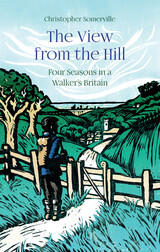
The View from the Hill
Four Seasons in a Walker’s Britain
Christopher Somerville
Haus Publishing, 2021
Collected notes from avid walker Christopher Somerville’s treks through the British countryside.
In Christopher Somerville’s workroom is a case of shelves that holds four hundred and fifty notebooks. Their pages are creased and stained with mud, blood, flattened insects, beer glass rings, smears of plant juice, and gallons of sweat. Everything Somerville has written about walking the British countryside has had its origin in these little black and red books.
During the lockdowns and enforced isolation of the COVID-19 pandemic, Somerville began to revisit this treasury of notes, spanning forty years of exploring on foot. The View from the Hill pulls together the best of his written collections, following the cycle of the seasons from a freezing January on the Severn Estuary to the sight of sunrise on Christmas morning from inside a prehistoric burial mound. In between are hundreds of walks to discover toads in a Cumbrian spring, trout in a Hampshire chalk stream, a lordly red stag at the autumn rut on the Isle of Mull, and three thousand geese at full gabble in the wintry Norfolk sky. Somerville’s writing enables readers to enjoy these magnificent walks without stirring from the comfort of home.
In Christopher Somerville’s workroom is a case of shelves that holds four hundred and fifty notebooks. Their pages are creased and stained with mud, blood, flattened insects, beer glass rings, smears of plant juice, and gallons of sweat. Everything Somerville has written about walking the British countryside has had its origin in these little black and red books.
During the lockdowns and enforced isolation of the COVID-19 pandemic, Somerville began to revisit this treasury of notes, spanning forty years of exploring on foot. The View from the Hill pulls together the best of his written collections, following the cycle of the seasons from a freezing January on the Severn Estuary to the sight of sunrise on Christmas morning from inside a prehistoric burial mound. In between are hundreds of walks to discover toads in a Cumbrian spring, trout in a Hampshire chalk stream, a lordly red stag at the autumn rut on the Isle of Mull, and three thousand geese at full gabble in the wintry Norfolk sky. Somerville’s writing enables readers to enjoy these magnificent walks without stirring from the comfort of home.
[more]

German Jerusalem
The Remarkable Life of a German-Jewish Neighborhood in the Holy City
Thomas Sparr
Haus Publishing, 2024
The fascinating history of German Jews who built a community just outside Jerusalem.
In the 1920s, before the establishment of Israel, a group of German Jews settled in a garden city on the outskirts of Jerusalem. During World War II, their quiet community, nicknamed Grunewald on the Orient, emerged as both an immigrant safe haven and a lively expatriate hotspot, welcoming many famous residents including poet-playwright Else Lasker-Schüler, historian Gershom Scholem, and philosopher Martin Buber. It was an idyllic setting, if fraught with unique tensions on the fringes of the long-divided holy city. After the war, despite the weight of the Shoah, the neighborhood miraculously repaired shattered bonds between German and Israeli residents. In German Jerusalem, Thomas Sparr opens up the history of this remarkable community and the forgotten borderland they called home.
In the 1920s, before the establishment of Israel, a group of German Jews settled in a garden city on the outskirts of Jerusalem. During World War II, their quiet community, nicknamed Grunewald on the Orient, emerged as both an immigrant safe haven and a lively expatriate hotspot, welcoming many famous residents including poet-playwright Else Lasker-Schüler, historian Gershom Scholem, and philosopher Martin Buber. It was an idyllic setting, if fraught with unique tensions on the fringes of the long-divided holy city. After the war, despite the weight of the Shoah, the neighborhood miraculously repaired shattered bonds between German and Israeli residents. In German Jerusalem, Thomas Sparr opens up the history of this remarkable community and the forgotten borderland they called home.
[more]

Central America and the Treaty of Versailles
Michael Streeter
Haus Publishing, 2010
They were in the United States' backyard, and in some cases under her direct protection. So in many ways it was little surprise when Cuba, Haiti, Nicaragua, Guatemala, Panama and Honduras joined the war on the Allied side in 1917 and 1918. Their involvement in the war was minimal, indeed scarcely noticeable, but it was enough. It earned these small relatively powerless nations—in Haiti's case barely a functioning state—an invitation to sit alongside the Great Powers at the Paris Peace Conference of 1919 and sign the Treaty of Versailles.
[more]

Epitacio Pessoa
Brazil
Michael Streeter
Haus Publishing, 2010
Brazil was one of the emerging world powers to be invited to the Paris Peace Conference in 1919. Having jettisoned her empire just thirty years before, the Portuguese-speaking nation was showed signs of becoming one of the financial powerhouses not just of Latin America, but of the world. Helped by abundant natural resources, cheap labour and large-scale immigration, Brazil’s economy had grown massively – and now it wanted to take its proper place in the society of world nations. In Paris, the country’s delegation was led by Epitacio Pessoa, a brilliant lawyer who had made his mark in national politics and was also a committed Europhile. It was a shrewd choice; helped by the Americans, Pessoa negotiated a deal to rescue Brazilian coffee from the German ports where it had languished since the middle of the war. He also helped win a place at the top table for Brazil in the new League of Nations. Pessoa was then rewarded by being elected president of Brazil – even though he was in Paris at the time. Yet even as Brazil enjoyed its moment of triumph on the international stage, the country’s political system was starting to unravel. Pessoa’s presidency ended in failure in 1922, its modest achievements overshadowed by bitter army revolts. And as Pessoa embarked on a new career as an international judge, his country slipped further into political infighting between elite oligarchies until the ageing republic finally folded in 1930. This, then, is the story of Epitacio Pessoa, the Treaty of Versailles and the rise and fall of Brazil’s tumultuous First Republic.
[more]

South America and the Treaty of Versailles
Michael Streeter
Haus Publishing, 2011
While Portuguese-speaking Brazil declared war on Germany in the First World War, the rest of South America held back. In the end no other South American nation joined the fighting. But four - Bolivia, Ecuador, Peru and Uruguay - did break off diplomatic relations with Germany in 1917, in sympathy with US policy and with the Allies in Europe. Their reward was a place at the Paris Peace Conference table and for the first time a chance to play a role on the world stage rather than just in their own backyard.
[more]
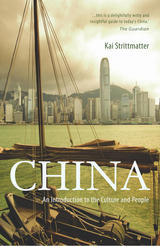
China
An Introduction to the Culture and People
Kai Strittmatter
Haus Publishing, 2010
It's time we got to know a little more about the Chinese. Did you know they don't eat soup, they drink it? That their surnames come before their first names? That their good sense is to be found not in their heads but in their hearts? Or that white is their colour of mourning? This guide to avoiding the numerous pitfalls of Chinese etiquette is both amusing and informative. The writer and journalist Kai Strittmatter lived and worked in China for ten years. This amusing, affectionate and perceptive book provides a fascinating guide to this lively, sociable and friendly people and their complex and often contradictory society. As the author says: "Be prepared for everything when you come to Beijing. It really is unbelievable what can happen here." The new material in this edition takes a critical look at the challenges posed by this, the next global superpower.
[more]
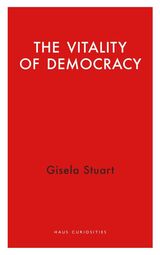
The Vitality of Democracy
Gisela Stuart
Haus Publishing, 2022
A reflection on the current state of and challenges to British democracy.
In The Vitality of Democracy, British-German politician Gisela Stuart argues for the urgency of expanded participation in the democratic process and considers the risks democracy currently faces. Although democracy is rife with difficult choices, she shows that if the people do not appreciate what makes this system work, they risk losing it. While no individual holds the answers, democracy allows for power to change hands, giving opportunities for different sides to have a chance at improving government for all.
Stuart reflects on challenges to British democracy since the mid-2010s. With the United Kingdom exiting the European Union and facing an overwhelming pandemic, restrictions to civil liberties were imposed that may have been unimaginable in the past. It is time to pause and reflect on the serious challenges currently posed to democracy and to the ability of the people to take part.
In The Vitality of Democracy, British-German politician Gisela Stuart argues for the urgency of expanded participation in the democratic process and considers the risks democracy currently faces. Although democracy is rife with difficult choices, she shows that if the people do not appreciate what makes this system work, they risk losing it. While no individual holds the answers, democracy allows for power to change hands, giving opportunities for different sides to have a chance at improving government for all.
Stuart reflects on challenges to British democracy since the mid-2010s. With the United Kingdom exiting the European Union and facing an overwhelming pandemic, restrictions to civil liberties were imposed that may have been unimaginable in the past. It is time to pause and reflect on the serious challenges currently posed to democracy and to the ability of the people to take part.
[more]

Greed
From Gordon Gekko to David Hume
Stewart Sutherland
Haus Publishing, 2014
In a riveting scene from the film Wall Street, Gordon Gekko proclaims that “greed is good.” The great philosopher David Hume, on the other hand, describes greed as the most destructive of the vices. The recent banking debacle and continuing uproar about executive bonus pay has placed the controversial issue of greed at the very heart of how we view modern society. Is Gekko’s maxim simply in need of some moderation? Or is Hume’s view too extreme?
In Greed, Stewart Sutherland examines these conflicting notions and discusses how we might approach the problem of greed today. He looks at the concept of incentives, which are essential for achieving results, and whether the desire for money is really as dangerous as it might seem. Powerful and timely, Greed is a much-needed look at an attitude that, for better or worse, is an unavoidable driving force in modern society.
In Greed, Stewart Sutherland examines these conflicting notions and discusses how we might approach the problem of greed today. He looks at the concept of incentives, which are essential for achieving results, and whether the desire for money is really as dangerous as it might seem. Powerful and timely, Greed is a much-needed look at an attitude that, for better or worse, is an unavoidable driving force in modern society.
[more]
READERS
Browse our collection.
PUBLISHERS
See BiblioVault's publisher services.
STUDENT SERVICES
Files for college accessibility offices.
UChicago Accessibility Resources
home | accessibility | search | about | contact us
BiblioVault ® 2001 - 2024
The University of Chicago Press









